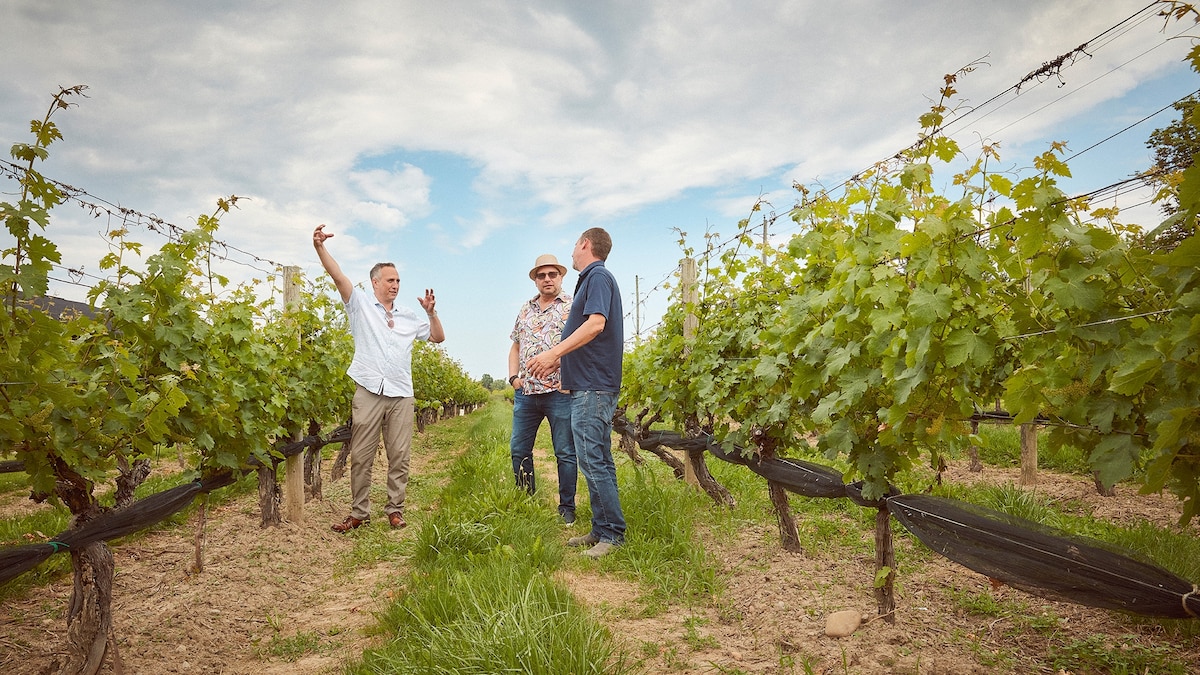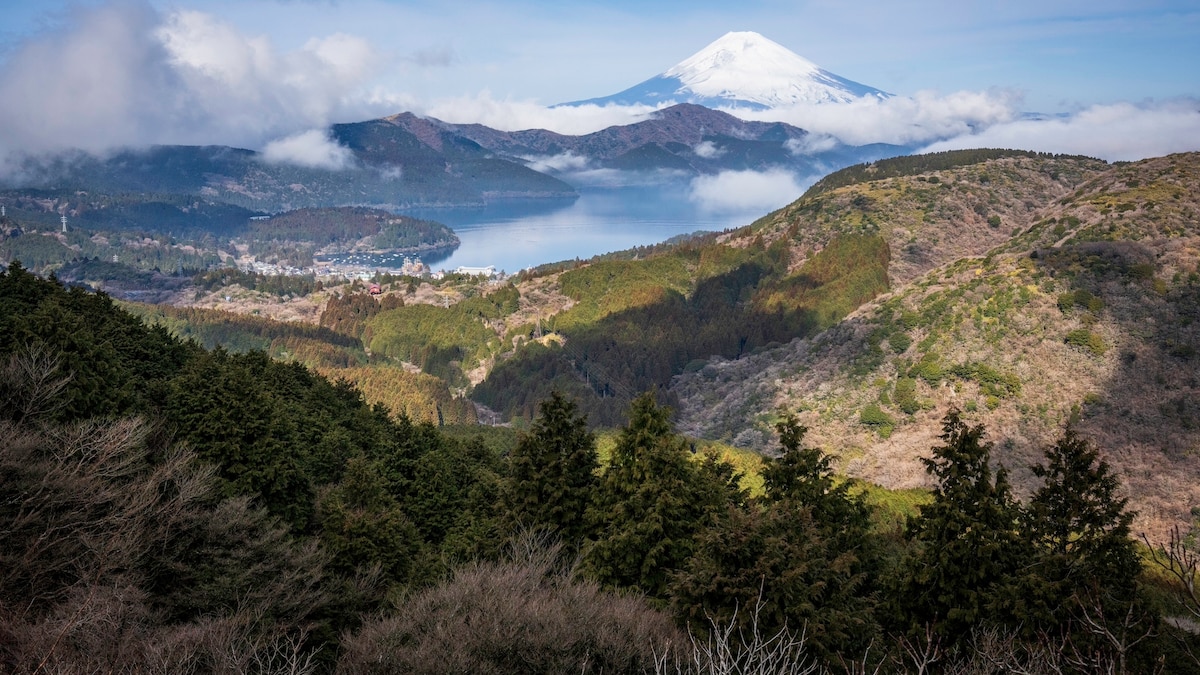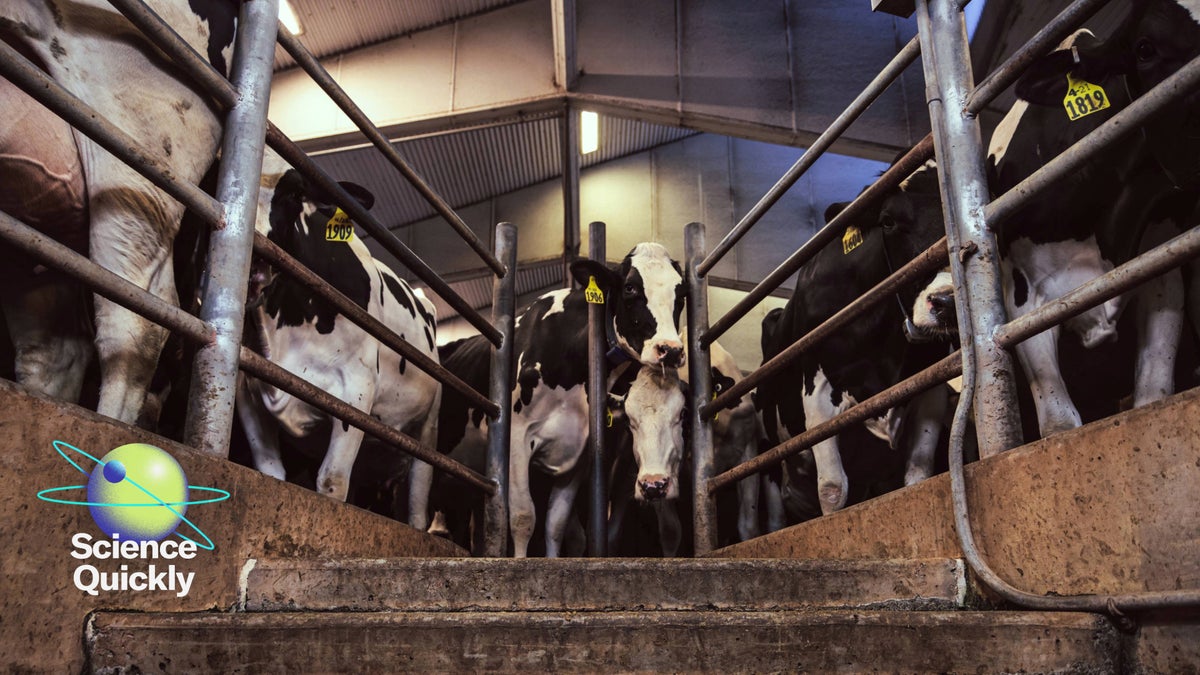Now Reading: In the shadow of Niagara Falls, Canada’s wine country offers a feast for the senses
-
01
In the shadow of Niagara Falls, Canada’s wine country offers a feast for the senses
In the shadow of Niagara Falls, Canada’s wine country offers a feast for the senses

This article was produced by National Geographic Traveller (UK).
“I’m not really a farmer,” Renee Delaney tells me sheepishly, despite our surroundings clearly suggesting otherwise.
Nearby, a chorus of grunting piglets wallow in a mud bath, overlooked by a pen of miniature goats. “All this started life 10 years ago with just one tomato plant, which I brought to put food on the table as a single mother,” says Renee. She gestures, with an arm covered in botanical tattoos, at her 19-acre plot at Small Scale Farms. An abundant tapestry of potato fields and vines bowing under the weight of juicy ripe tomatoes unfurls towards a distant red barn, which is home to the farm shop, painting a glorious picture of rural idyll.
Canada’s Niagara Region, in the province of Ontario, encompasses a verdant patch of vineyards and orchards. Set between Lake Erie and Lake Ontario, it’s about an hour’s drive south west of Toronto. The thundering waterfalls of Niagara Falls, long considered one of North America’s most spectacular natural sites, are undoubtedly the star attraction; however, since the 1980s, Ontario has also pinned itself to the map as an emerging wine-producing region. Paired with this booming viniculture, a grassroots culinary scene has sprung forth, offering plucky first-time growers like Renee opportunities to reap a living from the land.
From its backyard roots, Small Scale Farms has blossomed into a green refuge for the community, tucked away by the road six miles from the misty cascades of Niagara Falls.

Aside from running Small Scale Farms, Renee also runs a farm school, teaching agricultural techniques to a predominantly female cohort of first-generation growers.
Photograph by Liam Mogan

“We try to follow a minimalistic, low-intervention approach in everything we do,” says Ferox wine producer, Fabian Reis. “So, that involves avoiding pesticides. We use regenerative farming methods and lock in nutrients using cow manure and mushroom compost.”
Photograph by Liam Mogan
Renee also runs a farm school, teaching agricultural techniques to a predominantly female cohort of first-generation growers. As a result, Renee tells me, she feels more like a teacher than a hands-in-the-soil farmer. This is despite the fact she’s tending to her ramshackle chicken coop while wearing a T-shirt that proudly declares in bold white lettering: ‘I am a farmer’. “I’m super focused on teaching others about food security,” she enthuses, her burnt-orange hair braided into a neat plait. “And luckily, Niagara has one of the best growing climates in Canada, because we’re southern and sheltered.”
Inside the rustic farm shop, I find Richard Willett. Wearing a dapper trilby hat, the 57-year-old former hospitality executive is sourcing ingredients for a feast with friends this evening. Like many others during the pandemic, Richard traded the bright lights of the city for a more relaxed pace of life, relocating from Toronto to the quaint harbour town of Port Dalhousie in 2021. A passionate foodie, he’s utilised his love of home cooking to connect with neighbours in the Niagara Peninsula, including local smallholders and vintners.
In preparation for tonight’s meal, Richard is busy filling his basket with curly garlic scapes and soil-encrusted Jerusalem artichokes (known here as ‘sunchokes’). He inspects a slab of butter made from the milk of a water buffalo. “I’ve not seen this around here before; let’s give it a try,” he shrugs, adding it to the basket, explaining that he’s an instinctive, self-taught cook who likes to experiment in the kitchen. Richard is clearly keen to get cooking, but before he can throw his apron on, he wants to show me around his neighbourhood a bit, including a pit stop at a pioneering boutique vineyard.

Richard traded the city lights for a more relaxed pace of life after the pandemic, relocating from Toronto to the harbour town of Port Dalhousie in 2021. He’s utilised his love of home cooking to connect with neighbours in the Niagara Peninsula, including local smallholders and vintners.
Photograph by Liam Mogan
Cruising deep into the heart of Niagara’s wine country, the winding road carves through rolling hills of grapevines ripening in the midday sun. Punctuating this fertile landscape, upscale tasting rooms, some with adjoining farm-to-table restaurants and al fresco sculpture parks, create an enticing route for budding oenophiles to follow. Ontario’s first winery opened in 1866 and today the province is home to more than 150 vineyards, many of which focus on sustainability.
Nowhere is that more apparent than at Ferox; a young vineyard just minutes from the town of Niagara-on-the-Lake, where horse-drawn carriages take tourists past trinket shops and country inns. We pull up outside Ferox’s outhouses to be greeted by owner Fabian Reis and winemaker Cubby Sadoon — two hip thirtysomethings on a mission to create low-impact wine.
“Welcome to the Napa Valley of Canada,” Fabian says, with a grin, leading us into their sun-dappled courtyard, where grapes ferment in enormous silver vats just a few feet away. A table soon overflows with delicate dishes of elevated farm fare, including exquisite spears of earthy asparagus finished with a confetti-like scattering of edible flowers. It’s been prepared by Sicilian-born chef Adriano Cappuzzello, who heads up the vineyard’s new restaurant, The Patio.
Leaning back in his chair and swirling a glass of ruby-red cabernet franc, Fabien explains that the pared-back ethos extends way beyond the aesthetics of his vineyard, which produces 9,000 cases of wine annually. “We try to follow a minimalistic, low-intervention approach in everything we do,” he says. “So, that involves avoiding pesticides. We use regenerative farming methods and lock in nutrients using cow manure and mushroom compost. We’ve also been trialling the lightest-weight bottles possible to help reduce our carbon footprint.”
Cubby, who learnt his trade in the hallowed cellars of Europe, adds that while the very concept of Canadian wine once raised eyebrows, climate change is having an impact on this. “Places around the world once considered preeminent wine-growing regions are now really struggling. But in Ontario, we have the benefit of a varied climate,” Cubby says, noting that their wine-growing season also extends well into the winter months, thanks to Canadian icewine, which will be served with tonight’s meal.

Richard slices strawberries and rhubarb for a zabaglione dessert, served with Niagara’s summer fruits.
Photograph by Liam Mogan
It’s mid-afternoon and Richard’s guests are due to arrive soon, so we head for Port Dalhousie. Beyond the car window, tractors idle along country roads and figures crouch down in pick-your-own strawberry fields. Roadside stalls offer jars of preserved peach slices and lattice-topped pies baked by the local Mennonite community, who still use horses and buggies to bring their goods to market. Rural Niagra might only be an hour or so from the urban buzz of Toronto, but it feels a world away.
Walking through the door of Richard’s saltbox-style wooden home, which is as pretty as a doll’s house, the smell of roast porchetta embraces us. A hulking joint of Ontario-reared hog’s belly and loin has been cooking low and slow throughout the afternoon, sharing the pan with clusters of Jerusalem artichokes basking in the meaty jus. Richard retrieves it all from the oven.
A smorgasbord of hyper-local ingredients is laid out on the kitchen counter, including black walnuts from a nearby nut orchard. There are also lion’s mane mushrooms — each the size of a large grapefruit — and delicately frilled oyster mushrooms. Richard sourced these earlier from a friend who grows fungi at his home and sells them to some of Canada’s most prominent chefs from the boot of his car.
As Richard sautés the mushrooms in a dollop of water buffalo butter, for the starter, he recalls that his taste for fine dining developed at a surprisingly tender age. While his parents weren’t keen cooks themselves, they did enjoy dining out as a family, which they’d often do five nights a week. “I was eating frogs’ legs at the age of six,” he recounts with a smile.
A rap on the door signals the arrival of Daniel Speck, a sixth-generation vintner whose ancestors planted some of the first grapevines in Canada. He’s dropping off a bottle of riesling icewine from his Henry of Pelham vineyard to be used in tonight’s zabaglione, an Italian custard dessert. Steam is rising from a simmering pot of water, over which Richard vigorously whips farm-fresh egg yolks and a flurry of sugar. He finishes the custard with a generous splash of icewine as Daniel explains why cool-climate wine is considered such a prized tipple.

Richard Willett utilised his love of home cooking to connect with new neighbours in the Niagara Peninsula, including local smallholders and vintners. For an evening appetizer, he served pâté with homemade pickled onions and slices of sourdough.
Photograph by Liam Mogan
While Ontario’s Mediterranean summers and Siberian winters provide ideal conditions for crafting icewine, it can still be a perilous process, he says. Grapes are left to freeze on the vine into December, which concentrates the sugar, but also leaves the crop vulnerable to the elements. “Icewine is a risky business and expensive to make. We’re battling wild turkeys and deer eating the fruit, then crushing a mountain of grapes for a small amount of juice. But it’s worth it to produce one of the world’s great sweet wines,” he says, as Richard leaves the icewine-infused custard to cool.
An eclectic cast of friends arrives, including a bohemian neighbour, a former skateboard shop franchise owner who now likes to drive around town dressed as Santa during the festive period. Glasses of merlot from Ferox vineyard — a fruity number with lively bursts of pepper and chocolate — are poured and we take our seats in the garden with some sourdough, homemade chicken liver pâté and pickled onions.
Dusk arrives with the rich and earthy mushroom course, accompanied by twinkling fireflies. After that, the tantalising aroma of garlic rises from our plates, as Richard drizzles a vibrant green pesto, whizzed up in his food processor using scapes — the stalks of garlic plants from Renee’s farm — over slices of porchetta, its skin crisp with salted crackling.
“Sunchokes were important to the First Nations people in Canada, and among some of the first foods picked by Europeans and brought back to Europe,” Richard explains as he serves a hefty bowl of the roasted root vegetables.
Talk soon turns to what’s growing in Niagara’s plentiful farmlands — cherries and blueberries currently overflow from roadside stalls, I’m told, while the promise of apples, peaches and pumpkins is on the horizon. “To mark the end of the season, the grand finale is a zabaglione dessert, served with Niagara’s summer fruits,” Richard says, sliding plates of a berries smothered in a boozy blanket of frothed custard before us. It’s the perfect pairing; the honeyed syrup of icewine, which tastes like biting into a freshly baked peach, is balanced by the tartness of the raspberries and blueberries. “I’m leaving you with a sweet taste of Niagara,” Richard concludes, as we scrape our plates clean. Glasses are raised aloft to toast our chef, the indie farmers and the spirited winemakers of rural Ontario.
Published in Issue 28 (summer 2025) of Food by National Geographic Traveller (UK).
To subscribe to National Geographic Traveller (UK) magazine click here. (Available in select countries only).























